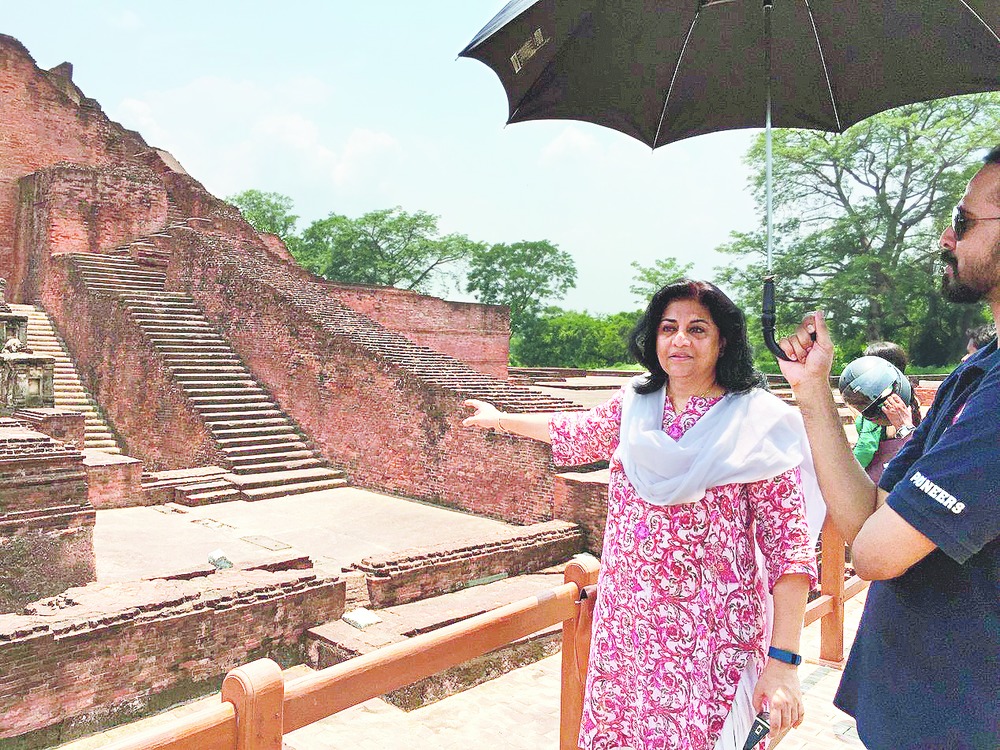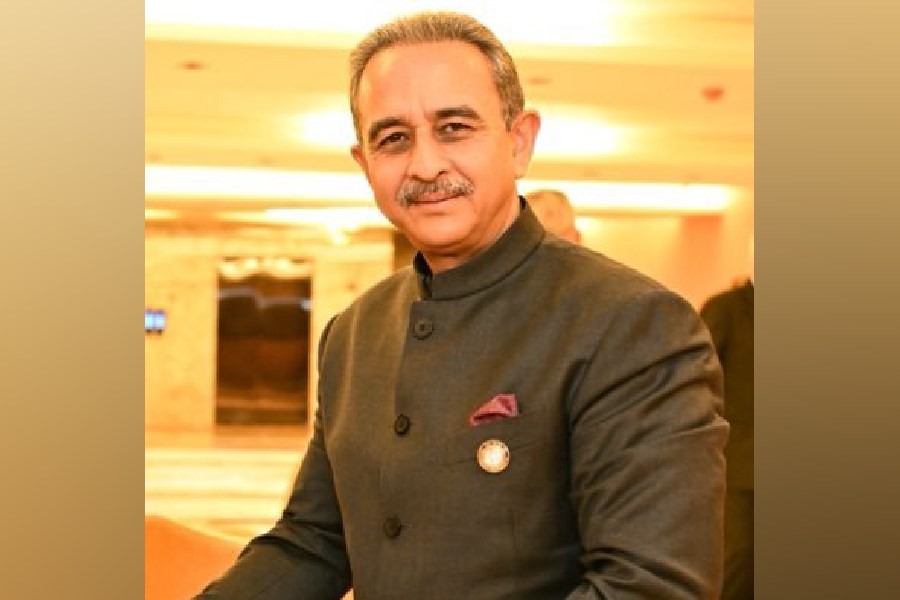
"...The whole establishment is surrounded by a brick wall, which encloses the entire convent from without. One gate opens into the great college, from which are separated eight other halls standing in the middle (of the Sangharama). The richly adorned towers, and the fairy-like turrets, like pointed hill-tops are congregated together. The observatories seem to be lost in the vapours(of the morning), and the upper rooms tower above the clouds."
As I stand among the red bricks of the Nalanda University and gaze at the layers of a civilization stretching over a thousand years, I cannot believe that I am actually looking at the same view as Chinese scholar Hiuen Tsang in AD 630.
In its heyday, Nalanda University accommodated over 10,000 students and 2,000 teachers. Tibetan sources mention the existence of a great library which comprised three large multi-storeyed buildings, one nine storeys high, housing not only religious manuscripts but texts on grammar, logic, literature, astrology, astronomy, and medicine, with a classification scheme developed by the Sanskrit linguist Panini.
Among those who headed this institution were the great scholars Shilabhadra, the Mahayana philosopher Nagarjuna and Aryabhata, the first of the major mathematician-astronomers of India.
It was a centre of learning from the fifth century AD to AD 1,200, flourishing under the patronage of the Gupta Empire in the 5th and 6th centuries and later under Harsha, the emperor of Kannauj. At its peak, the school attracted scholars and students all the way from Tibet, China, Korea, and Central Asia. Systematic excavations commenced in 1915 unearthing eleven monasteries and six brick temples neatly arranged on grounds 12 hectares in area.
I can only imagine the energy that Yijing (also known as I-tsing) writes about at Nalanda in India in AD 673: "Each morning, a bell was rung signalling the bathing hour which led to hundreds or thousands of monks proceeding from their viharas towards a number of great pools of water in and around the campus where all of them took their bath. This was followed by another gong which signalled the ritual ablution of the image of the Buddha. The chaityavandana was conducted in the evenings which included a 'three-part service', the chanting of a prescribed set of hymns, shlokas, and selections from scriptures."
Yijing states that the sheer number of residents at Nalanda made large daily assemblies difficult. This resulted in an adapted ritual which involved a priest, accompanied by lay servants and children carrying incense and flowers, travelling from one hall to the next chanting the service. The ritual was completed by twilight.
Nalanda declined as a centre of learning with its control shifting to ritualistic tantric learning rather than open inquiry and debate. Scholars no longer felt able to teach there and students were no longer attracted. By the time the Turks invaded India and reached Nalanda, there was little left to plunder. There were few students left and most of the books of the vast library had been taken away by Tibetan and Chinese scholars in an attempt to guard them from the narrow-minded ritualistic sects that had taken over Nalanda.
More than a thousand years later, I walk this ancient site with a new vice-chancellor, Gopa Sabharwal, who is trying to set up a new Nalanda University here. She waves at the Rajgir hills that is described in all the most sacred Buddhist texts, "We will be looking at the same hills that the Buddha must have looked at when meditating."
Only in India can we span thousands of years so easily. The past is present in every corner.
The ideas and approaches of the old will continue in the university she imagines - the sense of inter-disciplinary education, the architecture, the ethics and values. The width of the walls which kept the interiors cool, the wide open spaces that allowed interactivity, the eco-friendly bricks and the in-campus water bodies are all likely to be appropriated from the design of the ancient Nalanda University for the proposed campus, which will accommodate 2,000 students.
"There will be a lake in the middle fed through rain water, so that we do not take away the underground water reserves that local farmers use. Housing will be in cloisters and linked through verandas and covered streets as you see in the ruins around you," says the vice-chancellor. The future campus will have a net zero or near zero environmental impact. "Even the power we use will be eco-friendly," she adds.
While waiting for this vision to unfold, the practical vice-chancellor does not wait to start classes. The academic session of the university was launched on September 1, 2014, with 15 students in the School of Historical Sciences and the School of Environment and Ecology in a makeshift campus. Its next batch of 50 students are already enrolled and next year the number will rise to 150. Like the old Nalanda the new students are pan-Asian-from Korea, Thailand, and Japan. Her faculty too is international.
Gopa Sabharwal's vision is inspired by Nobel laureate Amartya Sen, who perhaps was inspired by another Nobel laureate, the great humanist poet Rabindranath Tagore. Amartya Sen graduated from Tagore's Patha Bhavana, the school around which Santiniketan's university cluster was built. Sen's maternal grandfather taught Sanskrit in Santiniketan. His mother studied there.
In Sen's words: "I had met him (Tagore) a number of times as a child, but I didn't have any real communication with him. I remember him as a benign, friendly presence. I am moved by Tagore's deep faith in the necessity for openness in the pursuit of knowledge, non-sectarianism, and humanism."
Tagore set up the Institute of Rural Reconstruction in 1922, three km from Santiniketan. The second but contiguous campus of Visva Bharati was subsequently located around the same place in 1923 and came to be known as Sriniketan. Silpa Bhavana at Santiniketan had already started training in handicrafts. Sriniketan took over the work with the objective of bringing back life in its completeness to the villages and help people to solve their own problems instead of solution being imposed on them from outside. An emphasis was laid on a scientific study of the village problem before a solution was attempted. A new type of school - Siksha-Satra - meant mainly for the children of neighbouring villages, was also set up at Santiniketan and shifted to Sriniketan in 1927. The Loka-Siksha Samsad, an organisation for the propagation of non-formal education amongst those who had no access to usual educational opportunities, was started in 1936. Siksha Charcha for training village school teachers followed next year. In 1963, an agricultural college was set up in Sriniketan and in 1977, the Rural Research Centre was set up.
Sitting in the makeshift simple campus with white PWD-style spartan housing and infrastructure, it is hard to see what Amartya Sen or Gopa see - till we all sit down for dinner at her austere home.
One of her students, Daniel, quit his job at IBM and came all the way from Mysore to study here. What does he like of this unique campus life? Alone, far away, rural? "The faculty is interesting, I have international exposure and yet it is all so grounded. We are actually in the middle of villages. I find this an authentic learning experience," he says.
Murari Jha, a faculty member teaching history who has just finished writing a book on the political economy of the Ganga, says, "I love the intellectual stimulation of a start-up, the close interaction between the faculty and students and the sense of community that all those in the new university have with each other. I was able to finish writing my book in peace."
As I watch the vice-chancellor make an ice-cream soda for Jha's three-year-old daughter Yashita, I think perhaps this is how legendary anecdotes are made.
Perhaps this little girl will grow up and relate a story to people about how the founding VC of Nalanda University made her ice-cream soda, just like we all know that Amartya Sen's first name was chosen by Tagore.
Santiniketan too was a start-up and grew because of Tagore's vision, backing by the national leaders of the day like Gandhi and Nehru. Indira Gandhi was sent there for education. It was also backed by the local villagers, whose very lifestyle and thinking were impacted by the impact they were making on the visiting scholars and students in the equal systems of intellectual exchange created by Tagore's vision.
The Nalanda University has the vision of Amartya Sen and the backing of chief minister Nitish Kumar behind it. Perhaps the next step is to start a Siksha-Satra, Loka-Siksha Samsad and Siksha Charcha to get those who live in Nalanda district more involved with it.










